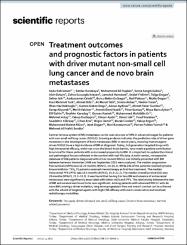| dc.contributor.author | Kahraman, Seda | |
| dc.contributor.author | Karakaya, Serdar | |
| dc.contributor.author | Kaplan, Muhammed Ali | |
| dc.contributor.author | Sezgin Göksu, Sema | |
| dc.contributor.author | Öztürk, Akın | |
| dc.contributor.author | Sucuoğlu İşleyen, Zehra | |
| dc.contributor.author | Hamdard, Jamshid | |
| dc.contributor.author | Yıldırım, Sedat | |
| dc.contributor.author | Şendur, Mehmet Ali Nahit | |
| dc.date.accessioned | 2024-03-26T07:05:16Z | |
| dc.date.available | 2024-03-26T07:05:16Z | |
| dc.date.issued | 2024 | en_US |
| dc.identifier.citation | Kahraman, S., Karakaya, S., Kaplan, M. A., Sezgin Göksu, S., Öztürk, A., Sucuoğlu İşleyen, Z. ... Şendur, M. A. N. (2024). Treatment outcomes and prognostic factors in patients with driver mutant non-small cell lung cancer and de novo brain metastases. Scientific Reports, 14(1). https://dx.doi.org/10.1038/s41598-024-56046-w | en_US |
| dc.identifier.issn | 2045-2322 | |
| dc.identifier.uri | https://dx.doi.org/10.1038/s41598-024-56046-w | |
| dc.identifier.uri | https://hdl.handle.net/20.500.12511/12395 | |
| dc.description.abstract | Central nervous system (CNS) metastases can be seen at a rate of 30% in advanced stages for patients with non-small cell lung cancer (NSCLC). Growing evidence indicates the predictive roles of driver gene mutations in the development of brain metastases (BM) in recent years, meaning that oncogene-driven NSCLC have a high incidence of BM at diagnosis. Today, 3rd generation targeted drugs with high intracranial efficacy, which can cross the blood–brain barrier, have made a positive contribution to survival for these patients with an increased propensity to BM. It is important to update the clinical and pathological factors reflected in the survival with real-life data. A multi-center, retrospective database of 306 patients diagnosed with driver mutant NSCLC and initially presented with BM between between November 2008 and September 2022 were analyzed. The median progression-free survival (mPFS) was 12.25 months (95% CI, 10–14.5). While 254 of the patients received tyrosine kinase inhibitor (TKI), 51 patients received chemotherapy as first line treatment. The median intracranial PFS (iPFS) was 18.5 months (95% CI, 14.8–22.2). The median overall survival (OS) was 29 months (95% CI, 25.2–33.0). It was found that having 3 or less BM and absence of extracranial metastases were significantly associated with better mOS and iPFS. The relationship between the size of BM and survival was found to be non-significant. Among patients with advanced NSCLC with de novo BM carrying a driver mutation, long-term progression-free and overall survival can be achieved with the advent of targeted agents with high CNS efficacy with more conservative and localized radiotherapy modalities. | en_US |
| dc.language.iso | eng | en_US |
| dc.publisher | Nature Research | en_US |
| dc.rights | info:eu-repo/semantics/openAccess | en_US |
| dc.rights | Attribution 4.0 International | * |
| dc.rights.uri | https://creativecommons.org/licenses/by/4.0/ | * |
| dc.subject | De Novo Brain Metastases | en_US |
| dc.subject | Oncogene-Driven Advanced Non-Small Cell Lung Cancer | en_US |
| dc.subject | Survival Related Parameters | en_US |
| dc.title | Treatment outcomes and prognostic factors in patients with driver mutant non-small cell lung cancer and de novo brain metastases | en_US |
| dc.type | article | en_US |
| dc.relation.ispartof | Scientific Reports | en_US |
| dc.department | İstanbul Medipol Üniversitesi, Tıp Fakültesi, Dahili Tıp Bilimleri Bölümü, İç Hastalıkları Ana Bilim Dalı | en_US |
| dc.authorid | 0000-0002-5823-1704 | en_US |
| dc.identifier.volume | 14 | en_US |
| dc.identifier.issue | 1 | en_US |
| dc.relation.publicationcategory | Makale - Uluslararası Hakemli Dergi - Kurum Öğretim Elemanı | en_US |
| dc.identifier.doi | 10.1038/s41598-024-56046-w | en_US |
| dc.institutionauthor | Hamdard, Jamshid | |
| dc.institutionauthor | Bilici, Ahmet | |
| dc.identifier.scopus | 2-s2.0-85187188671 | en_US |
| dc.identifier.pmid | 38461209 | en_US |
| dc.identifier.scopusquality | Q1 | en_US |



















